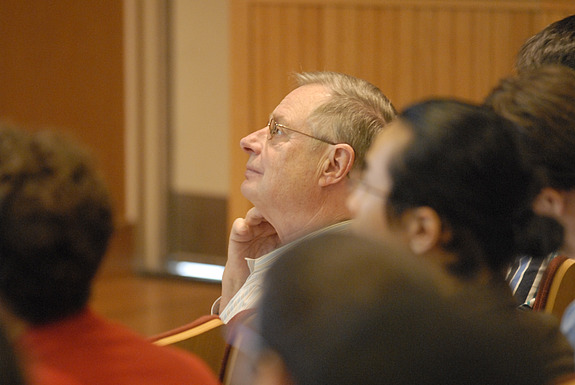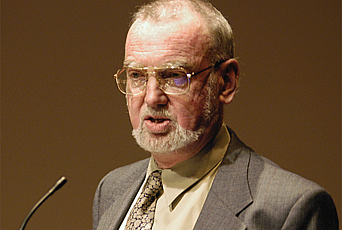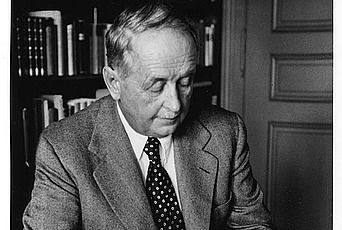Conference Celebrates Phillip Griffiths’s Achievements and Example

A conference on algebraic and differential geometry was held last fall in celebration of the seventieth birthday of former Institute Director (1991–2003) Phillip A. Griffiths, a Professor in the School of Mathematics, who will retire at the end of June. In the following passages, three conference participants comment on his influence and work, which has been central to the development of complex analysis, algebraic geometry, differential equations, and other areas.
Robert L. Bryant, Director of the Mathematical Sciences Research Institute (MSRI), Director of the IAS/Park City Mathematics Institute (PCMI), and former Director’s Visitor (1996) and School of Mathematics Member (1979–80):
It is a pleasure to write about my own experiences with Phillip, both as collaborator and as one who has benefited immeasurably from Phillip’s advice and encouragement throughout his career.
Of course, I had known of Phillip’s reputation, both as a mathematician and as a teacher, since my graduate school days. His great book with Joe Harris, Principles of Algebraic Geometry, had made a deep impression on me and, though I had not gotten beyond Chapter 1 by the time I finished graduate school, I still regarded it as one of the most important books in my library.
Shiing-Shen Chern, who organized a meeting on exterior differential systems in geometry in Berkeley in December 1979, introduced me mathematically to Phillip. Phillip and I were both invited to speak, and during the course of that meeting we discovered that we had quite a few interests in common. Our discussions began in earnest that spring. Phillip was interested in problems that were a considerable level above what I had been working on––specific questions about the integrals of the differential system that describes the Griffiths infinitesimal period relations and the exterior differential system that governed the overdetermined isometric embedding problem. Our paper on 3-folds with trivial canonical bundle was a result of those early conversations, as was the work on the overdetermined and determined cases of isometric embedding, which we did with Deane Yang and Eric Berger. Phillip always impressed me with his determination to follow a problem wherever it led, no matter what tools had to be learned and applied in the chase. As his students will tell you, seeing Phillip learning a new subject alongside you is a strong and inspiring motivator.
Our conversations and collaborations drew me into the Griffiths family, both mathematical and personal, and for this I am eternally grateful. The explorations of the geometry of differential equations that formed the basis of our long collaboration taught me an incredible amount about an enormous range of subjects: Lie groups and symmetry reduction of constrained variational problems, the role of homology and cohomology theories in the geometry of partial differential equations (PDE) (which formed the basis of our series of papers on characteristic cohomology), the geometry of characteristics and methods of integrability (always with an eye toward understanding the nature of integrability for PDE itself), the method of equivalence, and the geometry of the Poincaré-Cartan form.
I count myself lucky indeed to have this mathematical connection with Phillip, but it would be remiss of me to end this without mentioning his deeply inspiring example of service to the mathematical community, the academic community, and the world at large. That Phillip was willing, in the early 1980s, to undertake the Provostship at Duke and, over the following decades, give ever more of his time and talent to issues in education and training, not just in the United States, but worldwide, has motivated so many of us also to give back to our communities and to society at large. His bread cast upon the waters has yielded a great harvest indeed, one that continues to enrich us all.
Herb Clemens, Professor of Mathematics at the Ohio State University, former Director of PCMI, and former Member (1968–70, 2001–02) in the School of Mathematics:
We came together in mid-October to celebrate the seventieth birthday of Phillip Griffiths, one of the world’s leading mathematicians over the past forty-five years and a long-time advocate for and contributor to mathematics and mathematics teaching in the developing world. It reminded many of us of how our mathematical and professional lives were influenced by Phillip—in some cases, even formed under the umbrella of Phillip’s influence.
In the gathering, we also saw reflected once again the mathematical truism that great problems generate great mathematics. A great problem is like a giant compass that orients the mathematical lives of those that choose to pursue it. The great problem in Phillip’s case is the Hodge problem. It poses the challenge of proof or counterexample to the assertion that, in an algebraically defined object, topological classes that could come from algebraic sub-objects actually do come from algebraic sub-objects. The problem was posed more than fifty years ago, almost at the outset of the modern age of topology. The invisible, elusive but still beguiling guest at the October gathering at IAS was that problem, “the problem.” She has grown older now, made more beautiful and perhaps even more elusive by the half century of beautiful mathematics that surrounds and enhances her. Phillip has led, and continues to lead, by example and by achievement, in our advancing understanding of her mysteries.
Phillip has also led, and continues to lead, by example and by achievement, in his contributions to the institutions that cultivate and maintain mathematics and its teaching. And his attention has extended, and continues to extend, not only the institutions that formed and nourished all of us who gathered to honor him, but also institutions only now being born and beginning to take hold in the far corners of the world, corners that seem improbable or impossible to many in the mathematics community. However, Phillip’s impeccable intuitive understanding of things tells him something else, namely that these are shining opportunities for the future of mathematics, and for the shared purpose and shared sense of fulfillment that mathematics offers.
Mark L. Green (conference organizer), Director Emeritus of the Institute for Pure and Applied Mathematics (IPAM) and Professor of Mathematics at the University of California, Los Angeles:
A remarkable feature of Phillip’s career is reflected in his students. They have collectively made an impressive contribution to mathematics—one is a member of the National Academy of Sciences and many hold positions at some of the nation’s finest universities. Four have led national institutes (MSRI, IPAM, the Clay Mathematics Foundation, and PCMI) and many others have played important roles as chairs of major departments, in professional societies, and on deliberative bodies. At a festive dinner held in conjunction with the conference, Phillip’s students reflected on their experiences. What was striking was that, universally, Phillip had played a pivotal role in their professional development, and meeting him was a turning point in their careers and in their lives.
I cannot resist saying a few words about Phillip himself. What an extraordinary collection of qualities to find all in the same person—an intellect of the very highest order, a set of values and an instinct for fairness that have brought him the trust of numerous institutions and indeed of entire professions, modesty, toughness when needed combined with an instinctive sense of generosity and optimism, an ability to bring out the best in people and to rally them to a higher purpose, a nose for the central issue involved in any problem, and enormous energy coupled with unstoppable determination. All of this harmonizes beautifully with his remarkable warmth and loyalty as a friend, a quality that has led to many deep and enduring friendships that have now lasted for multiple decades. ■
Nurturing Science in the Developing World
The Institute for Advanced Study welcomes the best scholars from all over the globe, but with few exceptions Members and Visitors come from North America, Europe, and parts of Asia. The Institute has been expanding its international reach with programs to identify and nurture excellence in science in the developing world, where financial resources are scarce but human potential is enormous.
During his time as Institute Director, Phillip A. Griffiths helped establish the Science Initiative Group (SIG), which was created in 1998 to provide scientific guidance for the Millennium Science Initiative. The project was inspired by the vision of James D. Wolfensohn, then Chairman of the Institute’s Board of Trustees, and developed jointly with the World Bank to support centers of scientific excellence in the developing world. A recent SIG initiative, the Carnegie–IAS Regional Initiative in Science and Education (RISE), which supports university-based research and training networks to educate Ph.D.-level scientists in sub-Saharan Africa, has been enabled by Institute Trustee Vartan Gregorian, President of Carnegie Corporation of New York.


